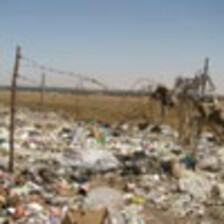The Electronic Intifada 2 May 2009
GAZA CITY, occupied Gaza Strip (IRIN) - Unexploded ordnance (UXO) and the uncontrolled dumping of rubbish pose the greatest environmental and public health risks to residents of the Gaza Strip, according to the UN Development Programme (UNDP). A further study is planned by the UN Environment Programme (UNEP).
Increased discharges of raw sewage, the contamination of ground and drinking water, polluted agricultural fields and other environmental effects stemming largely from the recent 23-day Israeli offensive in Gaza will be the focus of an upcoming UNEP assessment to be conducted by a team of eight experts in May.
Assessment results are expected by early July.
“Contamination of water and land, and the handling of hazardous waste and rubble are the most pressing issues [in Gaza],” said UNDP environmental officer Husam Tubail.
Hazardous waste includes waste from healthcare facilities, asbestos and other material mixed up with the rubble. It also includes UXO, said Tubail.
Asbestos
About 600,000 metric tons (mt) of rubble resulted from the bombardments — and some of this is mixed with asbestos, as most homes in refugee camps were built of concrete and asbestos, said Gaza environment quality authority chairman Yusuf al-Ghuraiz.
“Asbestos fibers are fine and when inhaled they enter the lung tissue, causing cancer,” said Gaza environment quality authority engineer Ibrahim Abdulla.
“Many houses in my neighborhood that were destroyed contained asbestos,” said Makram Hanoun from the A’ Tufa area of Gaza City. “I fear my children’s health is at risk from the toxic fumes.”
Rubbish risk
A major health threat is also posed by the accumulation of about 28,000 mt of municipal rubbish piled up across Gaza during the conflict due, in part, to movement restrictions, according to the UNDP in Gaza.
In Rafah about 10,000 mt of rubbish has been dumped by the shoreline in the Tala Sultan area and tons more are piled up east of Gaza City, said Tubail, adding that the local authorities lacked the equipment and resources to dispose of it.
The three main sites for dumping refuse in Gaza are reportedly already at maximum capacity.
The Gaza authorities are alarmed by the health risks posed by the number of children playing on or near municipal rubbish dumps, rubble and unstable substances.
Clearing UXO
Humanitarian organization MAG International and the UN Mine Action Service (UNMAS) are working to clear UXO to reduce the threat of death and injury, and to facilitate safe access to areas for internally displaced persons and humanitarian workers.
Seven people have been killed by UXO since the end of the conflict — one last week in eastern Gaza — according to Tubail.
Chemicals
“About 250 industrial facilities and factories — such as textile and food processing factories, and small workshops — were destroyed. It is still unclear what chemicals were released as a result,” said Tubail.
The Israeli military has admitted using phosphorus during the campaign, which ended on 18 January 2009.
Israel “used two types of white phosphorous during its operation; the first was used to mark targets in open areas and the second was used as a smokescreen with pieces of felt built into the shell to absorb the white phosphorous to protect soldiers,” Israeli military spokesman Major Avital Leibovitz told IRIN, saying both types of munitions were used according to international law.
“DIME and undepleted uranium were not used by the IDF [Israeli army] during the recent operation,” said Leibovitz.
UNDP and the Gaza authorities both estimate urgent rehabilitation needs of over $25 million. However, a recent appeal appears not to have been met so far.
This item comes to you via IRIN, a UN humanitarian news and information service, but may not necessarily reflect the views of the United Nations or its agencies. All IRIN material may be reposted or reprinted free-of-charge; refer to the copyright page for conditions of use. IRIN is a project of the UN Office for the Coordination of Humanitarian Affairs.

